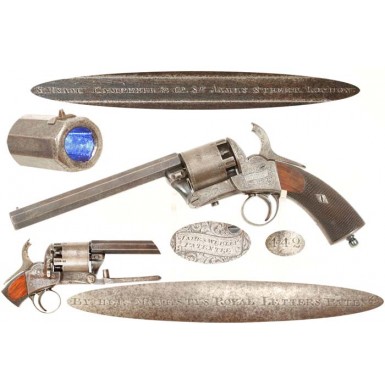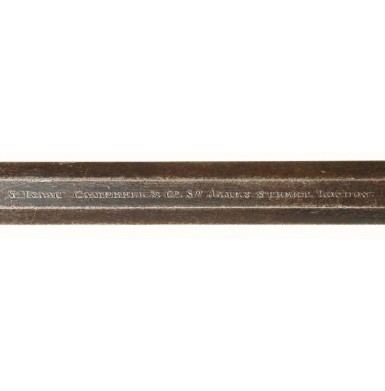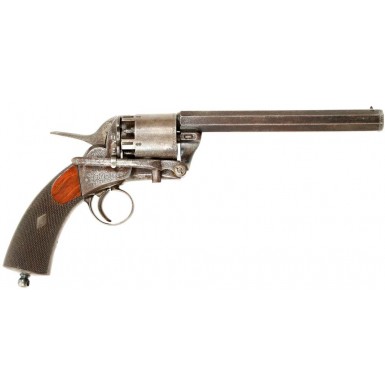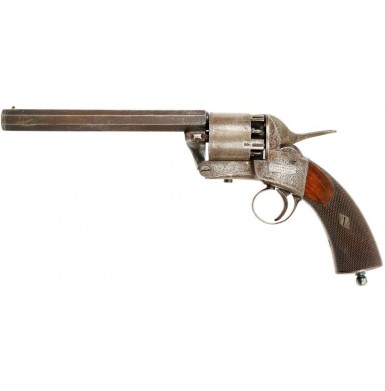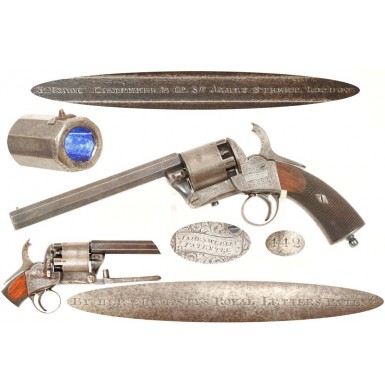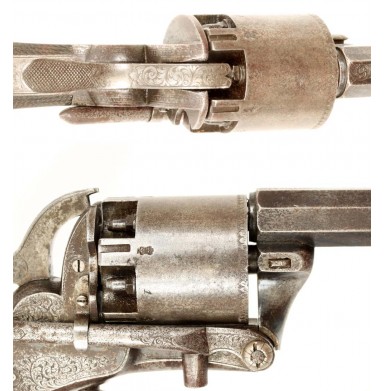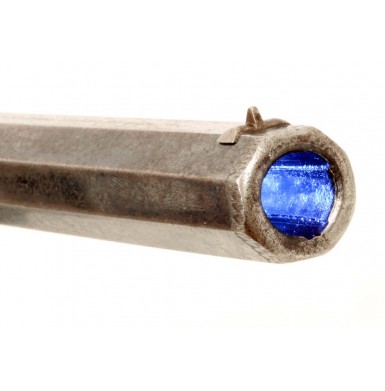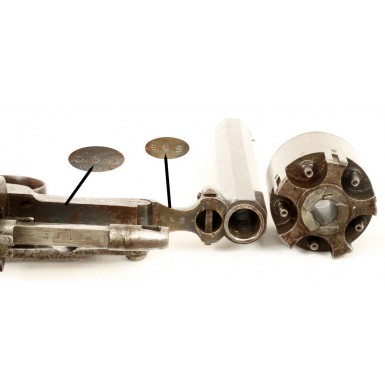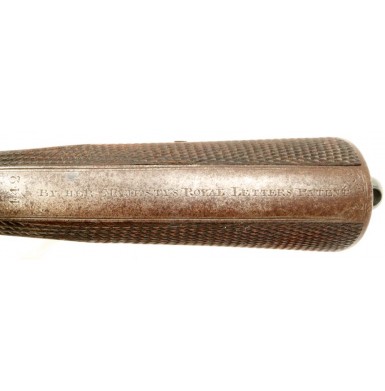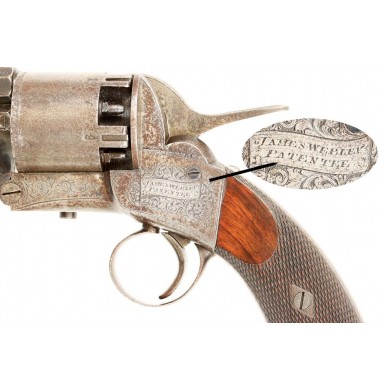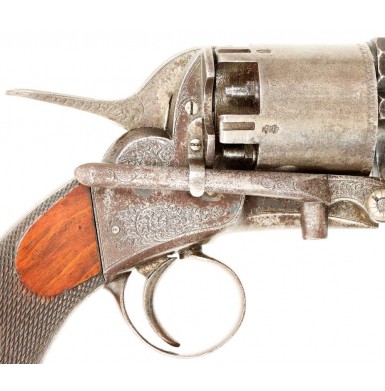S. Isaac, Campbell & Company Retailer Marked Webley Long Spur - Extremely Rare!
- Product Code: FHG-1796-SOLD
- Availability: Out Of Stock
-
$1.00
Brothers James and Philip Webley would together start what would become the most successful English revolver company to be established in England. James, the elder Webley, was born in 1807 and established himslef in the trade by the time that his younger brother Philip (born in 1813) was done with his apprenticeship. Both Webley’s initially worked as gunlock filers and gun lock makers, as well as “percussioners”, and by the mid-1830s were working together in that capacity on Weaman Street in Birmingham. James Webley was also working on producing his own complete firearms to sell under his own name, and by 1835 had a retail outlet at 14 St. Mary’s Row in St. Mary’s Square. In 1838 young Philip “acquired” the gun implement making company of William Davis by marriage to his daughter Caroline. Davis, a noted bullet mold and implement maker has passed away in 1831 and his wife Sarah and his daughter Caroline had continued to run the business until Philip married into the family. From that point, the Webley story centered on the old Davis business location at 84 Weaman Street, and would eventually expand to include #81-#91 Weaman Street. By 1845, at the age of 32, Philip was in a position to purchase the business from Davis’ widow. By the early 1850s the Webley brothers were producing, both alone and in joint venture, a variety of small arms including single shot percussion pistols, various repeating pistols such as pepperboxes, “transitional” pistols and early single and double action designs, as well as “ships pistols”, muskets and various long arms. Their customer list included the two largest and most important gun buyers of the era in England, the Honorable Board of Ordnance (the British Military) and the Honorable East India; whose private army protected the company’s investments around the world, and was one of the largest and best-equipped forces of the time. In 1853 the genesis of what would be the most lucrative part of the Webley business going forward occurred, James Webley’s design patents were filed for what would become known as the Webley “Long Spur”. The patent was number 743, granted March 29, 1853, for a new single action revolver design. The revolver was a percussion ignition handgun with a unique grip angle and a long, low, extended hammer spur that made the cocking of the action very fast. The design used the typical “open top” frame of the period, but had a hinged connection between the barrel and the frame, forward of the cylinder, that allowed the barrel to be tilted down with the removal of a wedge forward of the cylinder. This wedge engaged a slot in the cylinder arbor, much like with a Colt revolver, but the wedge was slotted and captive like a shotgun wedge of the time. The wedge was easily removed; the barrel easily tilted down, and the cylinder could be quickly removed for loading. In fact, period reports noted that the Webley design with its odd looking hammer was faster to shoot that a Colt revolver and the hinged frame made the gun faster to reload than a Colt. The initial design did not include a loading lever, but like most British revolver designs of the early 1850s, loading levers were soon introduced in a variety of patterns, and these changes made up much of the subsequent “types’ within a pattern of revolver design. The “Long Spur” was a handcrafted elegant piece, which was exceptionally well made within the limitations of a small format business of the time. However, the quality that went along with master craftsmen building the guns by hand meant two things, the interchangeability of parts was limited at best and the guns tended to be expensive. As a result, the Webley’s had a hard time competing with their biggest competitor in single action revolvers, Samuel Colt. Colt had established his manufactory in London in 1851 after The Great Exhibition, and the Webley’s could not compete with the Colt product on the basis of price, as the Colt revolvers were manufactured on the basis of interchangeable parts with an assembly line system. This motivated Philip in particular to pursue both theories of modern production and put significant effort and monies into the building of interchangeable parts guns in an assembly line fashion. In 1856 James Webley died, and Philip was left to lead the company forward. The following year Colt closed his London manufactory and left Philip Webley in the unique position of being able to fill the void left by the closing of the Colt plant. Webley had himself taken out two revolver patents in 1853 (#305 on February 4th and 2127 on September 14) for “improvements to revolver lock mechanisms” and these patents would form the basis for his famous “Wedge Frame” revolver that would help establish Webley as a premier maker of that style of handgun. In 1860 Webley’s two sons Thomas and Henry joined the company and it was renamed P. Webley & Son, with locations in Birmingham and London. Over the next few decades, Webley would become the premier English revolver maker with such famous designs as the Webley-Pryse series of revolvers, the Webley RIC (Royal Irish Constabulary), the “British Bulldog”, the Webley-Fosbery, the Webley “Mark” revolvers (Mark I “ VI), the Webley Government Model revolvers in .476 and .38, the Webley-Green, and even a line of semi-automatic handguns after the turn of the century. In 1877 the firm began to absorb large, old time Birmingham makers with the acquisition of Tipping & Lawden. In 1897 they acquired Richard Ellis & Company and the long time firm W. & C. Scott. At that time, the firm changed their name to The Webley & Scott Revolver & Arms Company. The success of the company continued through the Great War, but the enactment of the UK Firearms Act of 1920 significantly restricted English gun ownership, making it difficult for average Englishmen to own a firearm. As a result the firm’s sales of handguns was significantly curtailed due to the new restrictions, with their only major handgun customer becoming the British military, who maintained the Webley & Scott revolvers as their standard sidearm until 1964. As a result of the new business model they were forced to work with, the firm searched for other markets to explore. In 1924 they entered the air gun market, and remain a major player in that field today. They also expanded their line of sporting arms, becoming a well-regarded maker of high-end shotguns and double rifles. Webley & Scott has passed through a number of hands since the mid-1900s, and remains in business today making high grade sporting arms and air guns.
The Webley “Long Spur” was a particularly important gun in the history of the Webley firm due to the fact it was their first in house design and is referred to on the current company’s web site as their “first production revolver”. Due to the slow production process and expense of the guns, they were not manufactured in large quantities, with only a couple of thousand likely to have been produced between late 1853 and end of the 1850s. By the end of that decade the assembly line manufacture of more modern, double-action designs like Webley’s “Wedge Frame” had eclipsed the “Long Spur” and relegated it to a mere footnote in firearms history. The “Long Spur” was produced in three basic sizes and three basic models. The sizes were a “Small” (pocket), "Middle" (belt) and "Large" (holster) model. The pocket model was a 120-Bore (about .34 caliber), 6-shot handgun with a short barrel that was typically 3 ““ - 4” long, and was intended for pocket carry. The belt model was sized for carry in a belt holster, and was a 5-shot gun in 60-Bore (about .43 caliber) with a longer barrel, generally 4 ““ - 5”. The holster model, or what might be termed a “dragoon” model during the period, was a much larger gun and was intended to be carried in pommel holsters. It was manufactured in 48-Bore (about .46 caliber). This was also a 5-shot revolver with a longer (typically between 6 ““ - 7”) barrel. With the exception of a handful of 1st Model Pocket Revolvers, all of the Long Spur models were rifled with 3 broad lands and grooves, with the grooves being deeper than typically encountered on 19th century revolvers. Again, with the exception of a handful of 1st Model Pocket Revolvers, all Webley Long Spurs have cylinders that rotate clockwise. The 1st Model revolvers were produced without a loading lever and had the hinged frame previously discussed. The 2nd Model revolvers added a loading lever on the right side of the frame that was secured under the cylinder when not in use. This system was substantially different from most loading levers in use at the time. Many 1st Model revolvers were subsequently upgraded to 2nd Model standards with the addition of the loading lever. The 2nd Model also retained the hinged frame system. The 3rd Model revolvers introduced a pair of substantial changes. First the hinged frame was abandoned and the new design used a thumbscrew that projected from the barrel web and frame junction to secure the two parts together. The second change was to adopt a more conventional loading lever that was hinged and attached to the left side of the frame and secured against the left side of the barrel when not in use. The lever substantially resembled that patented by James Kerr of the London Armoury Company, which was used on many M-1854 Beaumont-Adams revolvers. Other than the changes in the loading lever system and the eventual change in the frame attachments systems, most Long Spurs were essentially identical across the three models. The all had the uniquely shaped, elegant frame, long, low hammer spur, octagonal barrels and two-piece checkered wood grips. The presence of a lanyard ring in the bottom of the grip frame certainly suggests that military contracts were their primary goal with the design. While no official contracts are known, it is assumed that a number of the larger caliber revolvers probably saw service in the Crimea and during the Indian Mutiny with British military officer’s that were required to provide their own arms, equipment and uniforms. In typical Webley fashion, the cylinder chambers are numbered. The guns were usually engraved with flowing floral scrolls and while not of the highest quality it was significantly better work than found on the more pedestrian arms of the period. The backstraps of the guns were engraved BY HER MAJESTY’s ROYAL LETTERS PATENT, and the side plate was typically engraved JAMES WEBLEY PATENTEE. If the gun was offered by a London or Birmingham retailer other than Webley, that retailer’s name was usually engraved on the barrel. Those guns sold in Birmingham or to the trade from Birmingham were marked with Birmingham proof marks, while the handful of guns sold by London retailers usually had London Proof House inspection marks. The revolvers were serial numbered, with the primary number engraved on the top of the backstrap and most of the major components stamped with the same number. The guns were typically blued, with case hardened hammers. Like the Colt revolvers of the era, a small extension hood on the top of the hammer served to keep broken percussion caps from flying back in the face of the shooter. Like the Colt, the nose of this extension was also notched to provide a rear sight when the hammer was cocked. Unlike the Colt the extension hood was quite thin and prone to breakage. William Dowell, author of the definitive work on Webley, The Webley Story, notes that more than half of the Long Spur revolvers that he has examined show this piece to be broken or repaired. He further notes that due to the relatively small production run of these guns, and their expense during the time of production that all sizes and models of Long Spur revolvers are quite scarce, and they are often the centerpieces of an advanced English revolver collection when one can be found for sale.
Offered here is a NEAR FINE condition example of a 2nd Model Webley Long Spur Holster Revolver. As would be expected this 2nd Model has the hinged frame and right side mounted loading lever that typify this pattern of revolver. The 48-Bore revolver has a 6 ““ octagon barrel with a muzzle that measures about .463” and a forcing cone that measures about .470”. The five cylinder chambers all measure about .460” +/- .005, and are marked with the expected chamber numbers from 1 to 5. The left side of the frame is engraved in a two line banner: JAMES WEBLEY PATENTEE. The backstrap is engraved: BY HER MAJESTY’s ROYAL LETTERS PATENT, with the serial number 442 engraved horizontally above the patent notice. The most intriguing part of the gun is the retailer mark engraved on the barrel. It reads:
S. ISAAC CAMPBELL & Co St JAME’s STREET LONDON.
The firm of S. Isaac, Campbell & Company was probably the most famous and most important supplier of arms, equipment and material to the southern Confederacy during the American Civil War. The firm was established in 1845 as Samuel Isaac, “Military Contractor & Tailor” in Chatham, Kent at 71 High Street. In 1848 the company expanded by opening an office in London at 21 St. James Street and by using the new moniker Isaac Samuel, Army Contractor. As the firm grew, selling more and more “military supplies’ (much like an old time chandler), Isaac changed the name to Samuel Isaac & Company in 1851 and then to S. Isaac, Campbell & Company in 1852. During this time the firm maintained their 71 High Street address in Chatham, but in mid-1861, sometime after the outbreak of the American Civil War, they moved their primary London location to 71 Jermyn Street, an address that is well known to collectors as it appears on many of the items sold to the Confederacy by the company. S. Isaac Campbell & Company had built their business on lucrative British military contracts. These included a major uniform contract to supply “clothing to the whole of the British Army in the East”, as well as a May 1858 contract to supply “regulation boots” (shoes) to the British Army. Unfortunately, a scandal alleging bribery and malfeasance resulted in the firm being banned from doing business with the British military in June of 1858. Ordinarily this would have ruined a military outfitter, who relied upon military contracts to remain in business, but luckily for the company the British “Volunteer” movement was afoot, a government sanctioned creation of local militia groups that could be called upon to augment the standing arm in times of war. For many of these groups, however, membership in such a “Volunteer Regiment” was much more akin to joining a shooting club or in some cases an elite social club, with some regiments formed by wealthy ne’er-do-wells who thought they looked dashing in a military uniform. While certainly not as substantial or reliable as government contracts, the items supplied to volunteers did not have meet the standards of the British Government, nor pass their rigorous inspection process. This allowed the company to make very good profits on mediocre quality goods. Delving into the field of potentially “shoddy” quality uniforms and accouterments provided S. Isaac, Campbell & Company the experience that they needed when the biggest cash cow to hit Great Britain during the 19th century arrived; the American Civil War. On May 10, 1861 Major Caleb Huse, chief purchasing officer for the Confederate military in England arrived in Liverpool, from whence he traveled to London and took residence at 58 Jermyn Street, across from the newly opened offices of S. Isaac, Campbell & Company at 71 Jermyn Street. About one month later, SIC & Co accepted their first order from the Confederacy, for 2,000 sets of accouterments, and a major economic relationship would be established that would remain in effect for the majority of the war. The basis of the deal arranged was that SIC & Co would acquire the necessary goods for Huse and charge a flat percentage over the actual cost of the items SIC & Co purchased, along with the cost of necessary expenses like insurance, shipping, etc. Over the coming years, SIC & Co would supply the Confederacy with nearly every conceivable item needed for an army in the field, its administration and its support. Items ranged from uniforms, blankets, cloth and buttons to accouterments, medical and scientific instruments and of course, guns. Not only did the firm supply the Confederate central government, but also Confederate state governments and Confederate speculators who purchased items on “speculation” hoping to sell them for large profits in the war torn and blockaded south. Speculative purchases ranged from military items and weapons to various luxury items difficult to get in the south during the war, including things like ladies dresses, china, flatware and even perfume. As of February of 1863 Huse had purchased over one million pounds worth of supplies from S. Isaac, Campbell & Company, including “417,262 worth of small arms, “110,525 worth of clothing, and “54,973 worth of accouterments, just to list some of the purchases. SIC & Co, in their typically “less than forthright” manner treated their Confederate customers with disdain and often inflated the “cost” of the items provided between 5% and 20%, and then charged their premium on top of that. The excessive costs resulted in an investigation of both SIC & Co and Huse, which cleared the latter of any wrong doing, but also discovered the second set of books being kept by SIC & Co that revealed their duplicity. Although the Confederacy essentially ended their relationship with firm “officially” by mid-1863, the ever wily Isaacs managed to sell additional items south during 1864 through what amounted to front men, offering items made in the Isaac’s own factories. The end of the Civil War and the loss of the war by the Confederacy sounded the death knell for the firm. With many outstanding invoices yet to be paid by the south, and even more paid via the Erlanger loan and southern cotton bonds that were now worthless, the firm was forced to declare bankruptcy in 1869. In the end, it was S. Isaac, Campbell & Company’s largest customer, the Confederate States of America that ruined the firm financially. Thanks to my friend Dave Burt “across the pond” for his wonderful monograph Major Caleb Huse C.S.A. 7 S. Isaac Campbell & Co for the detailed background on the firm.
The S. Isaac, Campbell & Company marking on this revolver, with the St. James Street, London address places the gun somewhere between late 1853 (the earliest date it could have possibly been produced) and early 1861, as SIC & Co were in their new location by May of 1861. Of course the firm did not discard old inventory that bore the old address, nor did they discard letterhead upon the move, as extant Confederate invoices from SIC & Co bearing the St. James Street address are dated as late as October of 1861. Realistically the revolver itself was probably acquired by S. Isaac, Campbell & Company sometime between mid and late 1850, and it is quite impossible at this time to know to whom it was sold. It is also very possible that as a design that came and went very quickly, that it sat around the SIC & Co establishment, collecting dust and not selling until the Confederacy was desperate for arms of all types, especially handguns. Interestingly, several English made swords with Confederate provenance are also known with the S. Isaac, Campbell & Company and the St. James street address, suggesting that they were clearly “emptying the warehouse” of stale inventory when the Confederacy came to call. These examples are referenced in our new book on Confederate purchased from England, The English Connection, which is also available through my web site. What is absolutely clear is that the engraving on the barrel matches that on the backstrap exactly, so the gun was retailer engraved at the Webley firm prior to delivery to S. Isaac, Campbell & Company, meaning that SIC & Co bought the gun directly from Webley and not from an intermediate company.
The revolver is in NEAR FINE condition overall, and the appropriate markings have been discussed above. The serial number, 442 is found throughout the gun, including on the rear of the cylinder, on the cylinder arbor pin, on the inside of the frame and on the inside of the barrel web. The two-piece checkered grips are lightly pencil numbered 442 in a period hand on their interior surfaces. The gun is elegantly engraved with tight floral splays on the frame with complimentary floral engraving on the butt cap, hammer, loading lever and trigger guard. The screw heads that secure the frame to the barrel are also enhanced, and light boarders are engraved on the leading edge of the cylinder and near the muzzle. The gun is 100% original and correct in every way. The gun retains about 20% of its original blued finish overall, most of which has faded, dulled and worn. Only some of the protected areas of the frame retain any bright blue, as do a couple of screws and the lanyard ring in the butt. The balance of the gun has a medium pewter gray and brown patina that is relatively even, and the gun is more pleasing in the hand, under normal light than the photos under bright lighting and against a harsh white background would lead one to believe. The barrel retains about 40% of its blue, mixed with a gray-brown patina. The blue is mostly faded and dull and mixes nicely with the patina. The barrel is essentially smooth and free of any significant pitting, but shows evenly distributed light pinpricking over its entire surface. This same pinpricking is present on the frame, as well as the butt cap and the triggerguard. This is suggestive of poor storage over the years, possibly in a somewhat damp environment. The cylinder remains somewhat freer of pinpricking, but shows some as well. The frame shows some lightly scattered pitting, as does the butt cap and the backstrap, which shows some areas of more moderate pitting as well. The engraving remains mostly sharp on the gun, with little smearing or blurring, and the markings also remain quite crisp. The cylinder chambers are clearly numbered 1 though 5 and the London proof house marks are crisply stamped between them. A London proof house view mark is present under the barrel as well, just forward of the frame. The gun is mechanically EXCELLENT and times, indexes and locks up perfectly. The frame hinge functions smoothly and the captive wedge is easy to slide out, but still locks the action together tightly. The cylinder retains all of its original cones (nipples) and they are in fine, crisp condition. The original lanyard ring mount is in place in the butt and retains some brilliant fire blue. Based upon a study of 2nd Model Long Spur revolvers in Dowell’s book, none appear to have a larger ring attached to the mounting ring, suggesting that this was optional or the large rings (if originally present) were all removed. The hammer remains crisp and sharp and retains the original notched hood at its nose, which is undamaged. The hammer retains lovely scroll engraving and a finely checkered spur. The original loading lever is secured to the right side of the frame and even its original spring retaining clip is in place and fully functional. Dowell notes that the two biggest weaknesses of these 2nd Model guns were the hammer nose hood and the spring that held the loading lever in place. This gun retains both original pieces with no damage. The loading lever functions smoothly and correctly in all respects. The original slightly notch is in place on the nose of the hammer hood and the original front sight is in place in its dovetail on the top of the barrel near the muzzle. The bore of the revolver rates VERY FINE and remains mostly bright with sharp 3-groove rifling its entire length. The bore shows only lightly scattered pitting along its length and some moderate frosting in the grooves. The two piece checkered grips are in VERY FINE condition and are solid and complete with no breaks, cracks, chips or repairs noted. The grips show some minor wear and flattening to the checkering, and a few minor handling bumps and dings, but are otherwise very crisp and sharp.Overall this is a really wonderful example of an extremely rare 2nd Model Webley Long Spur Holster Revolver in NEAR FINE condition with an exceptionally rare S. Isaac, Campbell & Company retailers mark. I have to admit that after more than two decades studying, collecting and selling English handguns and English arms purchased or imported by the Confederacy that I have never before encountered one with S. Isaac, Campbell & Company mark on it. I am sure there are others out there, there would have to be, but this is a truly rare marking and a very important one at that. With collectors paying thousands for small items used by the Confederacy with this retailer mark on them, I am quite certain that this may be a very special opportunity for an advanced collector to acquire a British revolver marked by the most important supplier to the Confederacy during the American Civil War. While it is possible that the gun was sold to a Volunteer officer in England, or a British military officer who served in the Crimea or during the Indian Mutiny, the fact remains that this gun is marked by S. Isaac, Campbell & Company. As scarce as crisp, complete Webley Long Spur revolvers are, coupled with the wonderful retailer marking, I have no doubt that this gun will find a very special home in a very special collection of English and or Confederate arms, and will be one of the prides and joys of that collection for years to come. This could literally be a once in a lifetime chance to own a very important revolver that is an exceptional piece of history!
SOLDTags: S, Isaac, Campbell, Company, Retailer, Marked, Webley, Long, Spur, Extremely, Rare

